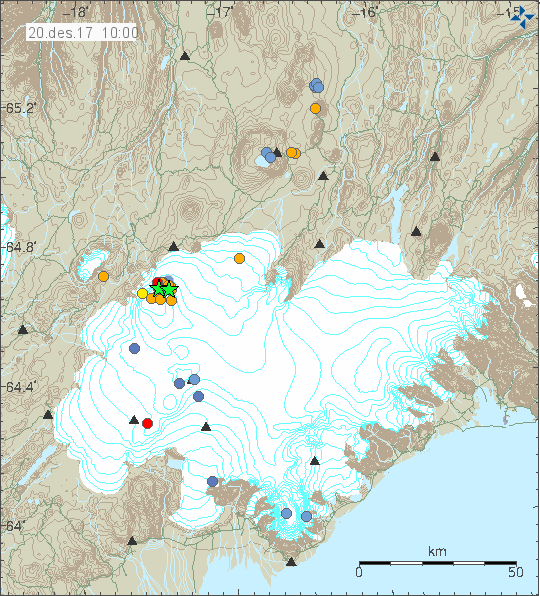Two powerful earthquakes shook Iceland's largest volcano early morning today, Wednesday. At 04:57 (4:57 am) the Seismic Monitoring System of the the Icelandic Meteorological Office detected the first sharp quake 4.5 km (2.8 mi) northeast of the center of the caldera. Half an hour later, at 05:29 (5:29 am) a second, more powerful 4.4 magnitude quake was detected 6,8 km (4.2 mi) east-northeast of the caldera.

Read more: Quick primer on Bárðarbunga, Iceland's most powerful volcano
A swarm of nearly two dozen smaller quakes followed the initial tremors, according to IMO, including three 2+ quakes. The epicenter of the activity has been at a depth of only 1-4 km (0.6-2.5 mi), with the first of the two 4+ quakes originating at a depth of 2.2 km (1.4 mi), the second one at a depth of 1.1 km (0.7 mi).
Any quake in an active volcano which is larger than three on the Richter scale is considered a powerful quake. Quakes larger than 4 are relatively rare, and are associated with significant geological activity in the volcano.
Significant levels of activity
Bárðarbunga, which is one of the most powerful volcanic systems in Iceland, is hidden beneath the north-western part of the ice cap of Vatnajökull glacier. Bárðarbunga has been showing significant signs of seismic activity since the end of the 2014-15 Holuhraun eruption. The activity is believed to be caused by the magma chambers of the giant sub-glacial volcano re-filling.
Growing activity has been detected in Bárðarbunga in recent months. A new geothermal area has opened up in the volcano's caldera. The sub-glacial geothermal activity has created two cauldrons in the ice cap which covers the caldera.
Read more: Scientists determine sub-glacial volcano Bárðarbunga is showing increased geothermal activity
A number of powerful quakes have been detected in the caldera since the end of the Holuhraun eruption, but there are no signs of imminent volcanic activity.
Read more: Why the constant earthquakes? Iceland is slowly being torn apart
Two powerful earthquakes shook Iceland's largest volcano early morning today, Wednesday. At 04:57 (4:57 am) the Seismic Monitoring System of the the Icelandic Meteorological Office detected the first sharp quake 4.5 km (2.8 mi) northeast of the center of the caldera. Half an hour later, at 05:29 (5:29 am) a second, more powerful 4.4 magnitude quake was detected 6,8 km (4.2 mi) east-northeast of the caldera.

Read more: Quick primer on Bárðarbunga, Iceland's most powerful volcano
A swarm of nearly two dozen smaller quakes followed the initial tremors, according to IMO, including three 2+ quakes. The epicenter of the activity has been at a depth of only 1-4 km (0.6-2.5 mi), with the first of the two 4+ quakes originating at a depth of 2.2 km (1.4 mi), the second one at a depth of 1.1 km (0.7 mi).
Any quake in an active volcano which is larger than three on the Richter scale is considered a powerful quake. Quakes larger than 4 are relatively rare, and are associated with significant geological activity in the volcano.
Significant levels of activity
Bárðarbunga, which is one of the most powerful volcanic systems in Iceland, is hidden beneath the north-western part of the ice cap of Vatnajökull glacier. Bárðarbunga has been showing significant signs of seismic activity since the end of the 2014-15 Holuhraun eruption. The activity is believed to be caused by the magma chambers of the giant sub-glacial volcano re-filling.
Growing activity has been detected in Bárðarbunga in recent months. A new geothermal area has opened up in the volcano's caldera. The sub-glacial geothermal activity has created two cauldrons in the ice cap which covers the caldera.
Read more: Scientists determine sub-glacial volcano Bárðarbunga is showing increased geothermal activity
A number of powerful quakes have been detected in the caldera since the end of the Holuhraun eruption, but there are no signs of imminent volcanic activity.
Read more: Why the constant earthquakes? Iceland is slowly being torn apart







